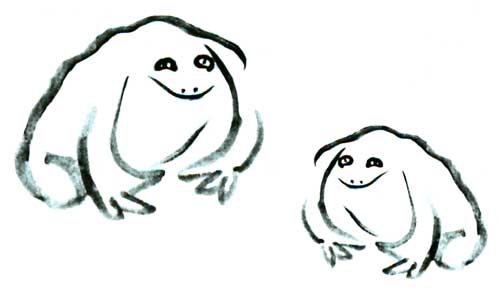 Spring washes over the garden; a torrent of sea-green buds swell with rainwater. Song sparrows and orange-crowned warblers begin their dawn chorus well before zazen, reminding cross-legged sitters in the ten directions that it is time to sow Tarahumara sunflowers and Trail o’ Tears beans.
Spring washes over the garden; a torrent of sea-green buds swell with rainwater. Song sparrows and orange-crowned warblers begin their dawn chorus well before zazen, reminding cross-legged sitters in the ten directions that it is time to sow Tarahumara sunflowers and Trail o’ Tears beans.
At Green Gulch Farm we lightly mark and honor the changing seasons of the year. Lightly, since from the thirteenth century onward Zen master Eihei Dogen has been haranguing wall-gazing meditators… Spring washes over the garden; a torrent of sea-green buds swell with rainwater. Song sparrows and orange-crowned warblers begin their dawn chorus well before zazen, reminding cross-legged sitters in the ten directions that it is time to sow Tarahumara sunflowers and Trail o’ Tears beans.
At Green Gulch Farm we lightly mark and honor the changing seasons of the year. Lightly, since from the thirteenth century onward Zen master Eihei Dogen has been haranguing wall-gazing meditators to remember that just as birth does not turn into death, neither does winter mark the onset of spring, nor summer conclude Primavera’s song.
Dogen also teaches that when you find your place where you are, practice occurs. And so, four times a year on the spring and fall equinox, and on the summer and winter solstice, we gather and take our place on the zendo deck overlooking the garden to welcome the light and dark seasons of the year.
At the spring equinox the sun stands directly above the equator, and for one moment, day and night are of equal duration. In the garden the ecliptic annual pathway of the sun intersects the celestial equator on or around March 21. As the forces of light and dark, drought and moisture, and warmth and coolness come into balance, every cell of every gardener’s True Nature stirs to life.
Our seasonal ceremonies are brief, impious, and slightly rococo. Every quarter year a random Zen elf sets up an outdoor altar dedicated to the season. This year, after zazen, we gather at the vernal altar. Behind us in the east, climbing high above Coyote Ridge, the sun burns a fire hole in the stretched silk sky of spring.
This year’s equinox altar is flanked by two huge pots of sulfur-yellow mustard flowers standing four feet high. The mustard blows untidy drifts of cross-shaped blossoms all over the abbess’ bowing mat. Nearby, out of the quiet circle of the incense bowl, gelatinous rainforest froglets from my daughter’s playbox crawl and proliferate, quivering as our bows shake the floorboards of the zendo deck.
The altar figure this season is a handmade Jizo holding a baby in her arms. Somehow, one of the rubber froggies has made it up to her shoulder to stare bug-eyed at the assembly. A ceramic caterpillar dressed in dapper chartreuse, lavender, and wine-red stripes greets spring on an altar covered with metal, paper and plaster-made creatures—turtles, grasshoppers, frogs, and butterflies. Pastel candles flicker nearby.
A few years ago for the spring equinox celebration the head priest for the service came to the ceremony wearing his T’ang dynasty robes and a large grocery bag pulled over his head. The bag was painted half black and half white in honor of the balance of dark and light that characterizes the vernal season. What I remember best from that distant spring, beyond the drama of the bi-color bag, is the surge of perfume pouring out of the garden lilacs draped over the equinox altar.
This season we bow, and chant, and offer fresh verses to the spring: haiku from Okusan, Suzuki-roshi’s widow; lines from Chaucer; slam poetry mixed with Shakespeare and Sylvia Plath; and all interlaced with spontaneous Zen quips. But even as we honor this vernal moment, spring recedes.
Spring is a black-water river running dark, with sunlight on the surface. Still, as eighth-century Chinese Zen master Shih-t’ou Hsi-ch’ien noted, light and dark are not one, not two. Instead, the subtle source is clear and bright, and the branching streams flow on.
Next vernal equinox I’ll bring a reaper’s scythe to the garden altar, and a handful of stinging nettles and rank skunk weed. In order to balance all the lilacs and colored frogs, I’ll bring the powdered mouse bones that I found in the scorched, electrocuted springtime nest behind the wireworks of our pump house. I’ll bring this, and more, to honor dark and light merging together in timeless spring.
Thank you for subscribing to Tricycle! As a nonprofit, we depend on readers like you to keep Buddhist teachings and practices widely available.